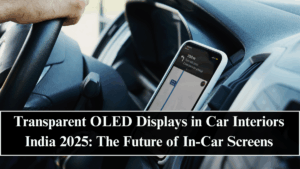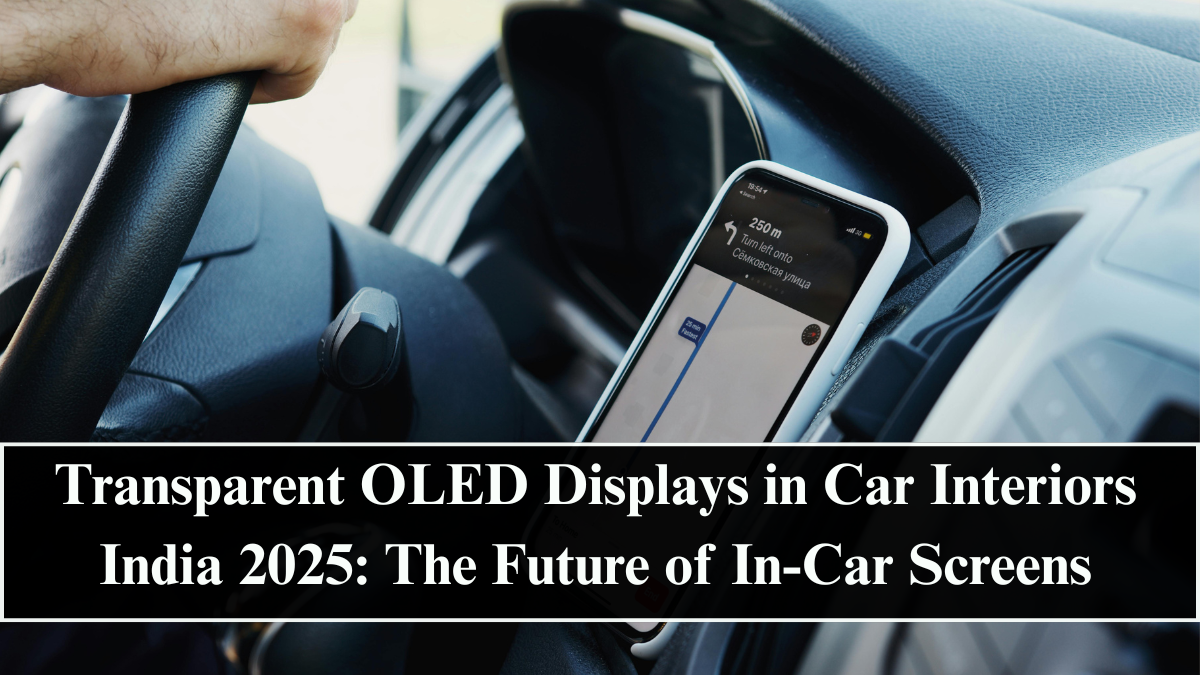The car interior of 2025 looks radically different — and much smarter. With Transparent OLED Displays in Car Interiors India 2025, automotive design is evolving beyond traditional dashboards. Transparent screens embedded in windshields, dashboards, and even windows are redefining how drivers and passengers interact with vehicles.
This technology merges digital functionality with physical space, creating seamless augmented-reality experiences while maintaining visibility and safety. From heads-up displays (HUDs) to infotainment overlays, transparent OLEDs (T-OLEDs) are becoming a cornerstone of futuristic in-car design.

What Are Transparent OLED Displays?
Transparent OLEDs use organic light-emitting diode technology with see-through panels that allow both light transmission and image projection. Unlike conventional LCDs or LEDs, they don’t require backlighting — giving automakers freedom to place them anywhere inside the vehicle.
This flexibility allows designers to integrate displays into windshields, side windows, rear-view mirrors, or panoramic roofs, providing real-time data without clutter.
In essence, transparent OLEDs transform car surfaces into interactive digital canvases, merging visual appeal with advanced functionality.
Adoption in Indian Automotive Industry
In 2025, leading automakers like Tata Motors, Hyundai, and Mahindra are exploring T-OLED technology for premium and electric models. Collaborations with tech leaders such as LG Display, Samsung, and Continental Automotive are driving early adoption in concept and production vehicles.
Luxury EVs showcased at Auto Expo India 2025 introduced augmented windshields displaying speed, navigation, and road alerts directly on glass. This innovation not only enhances the user interface but also aligns with India’s growing connected vehicle ecosystem.
Additionally, domestic startups specializing in automotive UI — particularly in Bengaluru and Pune — are developing custom OLED integration kits tailored for Indian driving conditions and ambient lighting environments.
Key Applications in Cars
Transparent OLED displays are being used for a variety of cutting-edge functions inside vehicles, including:
-
Heads-Up Displays (HUDs): Projecting navigation and safety alerts directly onto the windshield.
-
Smart Dashboards: Combining infotainment, driving analytics, and AI voice control in a unified display.
-
Rearview and Side Windows: Acting as dynamic mirrors or blind-spot cameras.
-
Passenger Entertainment Screens: Transparent panels on window glass for streaming or information overlays.
-
Gesture-Control Interfaces: Allowing users to interact with virtual elements projected on glass.
These applications not only enhance convenience but also minimize distractions by keeping the driver’s focus on the road.
How Transparent OLEDs Improve Safety and UX
The integration of transparent OLEDs is as much about safety as it is about aesthetics. Real-time data like lane warnings, collision alerts, and speed indicators appear in the driver’s natural line of sight.
This eliminates the need to look away from the road to check dashboards or screens. Combined with AI-powered eye-tracking systems, these displays adjust brightness, contrast, and position based on driver posture and visibility conditions.
Passengers also benefit from contextual information overlays — for example, identifying nearby landmarks or route highlights through interactive window displays.
Design and Sustainability Impact
Beyond tech, transparent OLEDs are redefining automotive interiors with minimalist and futuristic designs. By replacing bulky display units with integrated glass panels, manufacturers are freeing up cabin space while reducing component weight.
Moreover, T-OLED panels are energy-efficient and compatible with solar-assisted EV architectures, supporting India’s broader push for sustainable mobility. Advanced materials and low power consumption also contribute to better thermal management and longer battery life in electric vehicles.
The Road Ahead: Toward Fully Augmented Vehicles
By 2025, Transparent OLED Displays in Car Interiors India are leading the transition toward fully augmented mobility experiences. As costs decrease and durability improves, expect mid-range EVs and connected cars to adopt this technology at scale.
The next phase involves multi-layer OLED integration — where transparent and flexible panels wrap around vehicle interiors — allowing users to interact with an immersive digital environment. Cars will no longer have separate “screens”; instead, the entire interior will become a responsive interface.
In the future, India’s roads may be filled with vehicles where glass isn’t just for visibility — it’s for communication, navigation, and connection.
FAQs
What are transparent OLED displays in cars?
They are see-through digital screens that can display data and visuals directly on glass surfaces like windshields and windows.
How do they improve driver safety?
By projecting information directly within the driver’s field of view, they reduce distraction and enhance situational awareness.
Are Indian automakers adopting this technology?
Yes, brands like Tata Motors, Hyundai, and Mahindra are exploring transparent OLEDs for premium and electric models.
What are some practical uses of T-OLEDs in vehicles?
They’re used in heads-up displays, smart dashboards, side mirrors, and passenger infotainment windows.
What is the future of OLED technology in automotive interiors?
Transparent OLEDs will evolve into full-cabin interactive surfaces, creating immersive, voice- and gesture-controlled experiences for both drivers and passengers.
Click here to know more.
